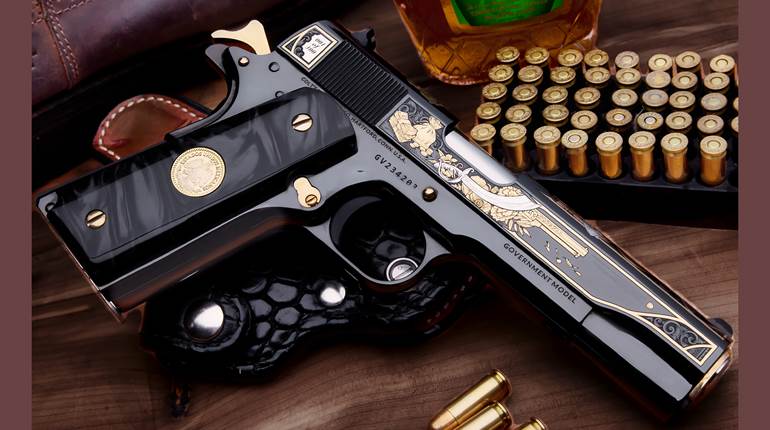
Its profile is as iconic as any firearm ever designed. The design is complex, fragile, yet beautiful and sophisticated—a clear reflection of its designer. Long after its demise as a service pistol, it retains a following of steadfast collectors. The Pistole Parabellum 1908 or Parabellum Pistol is something of an enigma, an enticing and exciting arm charm that seems to raise the status of its wearer but wholly lacking in terms of practicality.
Commonly referred to as the “P08 Luger” or “German Luger” by the truly plebeian, the Parabellum Pistol actually served as a starting point to the modern semi-automatic pistols of today. It is arguably the first successful semi-auto pistol, and it introduced the 9x19 Parabellum cartridge to the world. That cartridge remains one of the most popular cartridges in the world 114 years after its introduction. Say what you want about the 9 mm, any device or product that commands the marketplace for more than a century must have a lot going for it, and its designer must have had a stroke of genius.
To understand the P08 one needs to have an understanding of its inventor. Georg Luger was born in Steinach am Brenner, Tyrol, Austria, in 1849 to a surgeon, Dr. Bartholomaeus von Luger. Early on the Luger family immigrated to Italy where the doctor taught at the University of Padua. Georg clearly was of the manor born, well-educated and equally at home speaking Italian as German. He trained as an accountant at Wiener Handelsakademie (Vienna Commercial Academy), the predecessor to today’s Vienna Business School.
In 1867 Luger enlisted in Reserve Officer Cadet with the 78th Infantry Regiment of Austria. His marksmanship skills garnered the attention of his superior officers, who sent him to the Austro-Hungarian Military Firearms School at Camp Bruckneudorf. He became an instructor there, was promoted to lieutenant and moved into the reserves. It was while at this school that his interest in automatic loading devices was piqued.
After his military hitch, Luger took a position as an accountant at the Jockey Club in Vienna, an establishment of fine social status. There he met Ferdinand von Mannlicher, an Austrian engineer and small arms designer. Mannlicher’s passion was also in loading devices—he is credited with inventing the en bloc clip—and Luger’s interest in semi-automatic feeding devices was rekindled. The men worked on rifle magazines for a time.
Luger had a brief stint at Ludwig Loewe & Company. By 1894 Loewe had died and the company evolved into Deutsche Waffen und Munitions Fabriken (DWM), and Luger was demonstrating a Hugo Borchardt-designed pistol to the U.S. Army, which rejected the design. Luger took detailed notes of the army’s criticism of the Borchardt pistol, returning to Berlin and incorporating improvements based upon those criticisms. The result in 1898 was the Parabellum Pistol.
In typical Teutonic fashion the Parabellum Pistol is a somewhat complex design, flawlessly executed in a style befitting its patrician roots. It is a short-recoil-operated, toggle-locked semi-automatic pistol built on a relatively large, hand-filling frame. The P08 is fed from a single-column, 8-round detachable magazine, though a 32-round drum magazine was eventually made for it. Barrel lengths ranged from 3 3/4” to 7 7/8”, with a nominal weight of 31 oz. Its sights are fixed and roughly regulated for 50 meters. Grips are checkered walnut, and the metal finish is a gorgeous velvet-like rust blue with some parts like the locking bar and safety switch given a “straw” finish.
Luger was an ardent adherent of accuracy, and his famous pistol has a deserved reputation for precision, due in no small part to its closely fitted components. Paradoxically, it is that same fine fitting of parts that contributed to its equally deserved standing as a temperamental pistol. In the presence of dirt and/or a lack of lubrication, the P08 has an unfortunate habit of stuttering. Wars were still conducted in often filthy environs, where dirt, dust and mud were the order of the day. The P08 was—no surprise—not an everyman’s pistol; it was usually reserved for officers.
Nonetheless, the sleek 55-degree grip angle, circular trigger guard and forward-looking toggle action captured the hearts of a number of military services, even if the Americans found it lacking. The Swiss Army adopted the Parabellum Pistol in 1900, chambered in its original 7.65x21 chambering with a 4 3/4" barrel. Four years later the German Imperial Navy accepted the P04 version of the Parabellum Pistol, featuring a 5 7/8" barrel and a two-position rear sight graduated for 100 and 200 meters. In 1908 the Bolivian Army made the P08 chambered in 9x19 mm its official sidearm for officers.
In what has become one of the most sought after versions, the Lange Pistole 08 or Artillery Luger was deployed to German artillerymen as a personal defense weapon. The Artillery Luger is a pistol/carbine chambered in 9x19 mm with a 7 7/8" barrel, a 32-round drum magazine, an 8-position tangent rear sight calibrated out to 800 meters, a detachable shoulder stock and a leather holster. If you can find one of these complete today, figure on lightening your wallet in excess of $5k.
The U.S. Army took another look at the Parabellum Pistol during its search for a large-caliber pistol in the trials of 1906 and ’07. DWM provided a pair of Lugers chambered in .45 ACP for evaluation, serial numbers 1 and 2. Serial number 2 is the only one known to survive and it is in a private collection. Estimates on its value are in excess of $1 million.
No fewer than 18 countries adopted some version of the Parabellum Pistol during its 42 years of manufacture. Countless more police agencies and individual officers used a commercial version of this pistol in their daily duties as well. Decades after DWM quit producing the Luger, importers have brought replicas of Georg Luger’s famous pistol to the marketplace. Many—perhaps most—of the original DWM pistols found in the U.S. made the trip here as wartime souvenirs.
Today, as it was a century ago, the Luger pistol carries with it an aura of refinement. Despite its not-so-robust reputation, it remains a beautiful fashion accessory to one’s nostalgic side or his gun safe. The World War I trench grunt and the modern operator in the sandbox would not want such a beauty at his side as he goes about his somewhat disagreeable task list. But if he is a gun guy, he probably wants one in his home safe just for the panache it brings.
Fun Fact:
Using an Artillery Luger to make an 800-meter shot would be a pretty ambitious undertaking. With a 124-grain FMJ and a muzzle velocity of 1,200 fps and a muzzle energy of 382 ft.-lbs., at 800 meters the bullet would have to have risen and fallen some 150 feet above the line of sight, and when it arrived on target it would be traveling at 511 fps with just 72 ft.-lbs. of energy remaining in it.





































